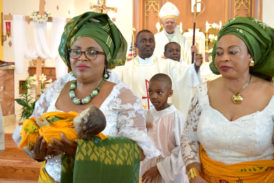By Engy Magdy, Special to The Tablet

CAIRO – Two thousand years ago, the Holy Family fled to Egypt to take refuge from the persecution of King Herod. Today, Christians are invited to make a pilgrimage in their footsteps.
There are more than two-dozen places the Holy Family visited during their time in Egypt, which lasted three years, six months and 10 days, according to the Coptic Orthodox Church. The Virgin Mary, Child Jesus and Joseph passed through several places from Arish through the Delta and Cairo, to Assiut in Upper Egypt.
For the first time, the Egyptian government is interested in developing these sites and turning them into a tourist attraction – even seeking to include them on the United Nations Educational, Scientific and Cultural Organization’s List of Intangible Cultural Heritage to give them a place on the international tourism map.
While Jerusalem, home to the Church of the Holy Sepulcher, is of particular importance to Christians, and Jordan is the site of the Baptism of Jesus Christ by John the Baptist in the Jordan River, Egypt has 25 sites visited by the Holy Family. The Egyptian Ministry of Tourism is currently working in cooperation with the Coptic Orthodox Church to implement a huge program to develop these sites, as well as restore archaeological sites, and qualify them to receive tourists along a route that extends more than 1,864 miles.
“The Path of the Journey of the Holy Family in Egypt” will be implemented in phases. Stops will include the Church of St. Sergius and its surrounding area in old Cairo, the monasteries of Wadi El-Natrun in Beheira governorate where the largest number of monasteries and churches are located, the Tree of the Virgin in Matariya in Cairo, Gabal El Teir Monastery in Minya and all of the archaeological installations in Assiut.
The journey will start from the old Cairo area that was known as Babylon Fortress, where the Holy Family lived in a cave that lies in the Church of St. Sergius, and it ends at Mount Dronka, where there is an old cave in the mountain where the Holy Family stayed before their return trip.
Among many other places, the journey includes Gabal El Teir Monastery; the Muharraq Monastery in Assiut, where the Holy Family spent six months in its cave; Hanging Church and the Virgin Mary’s Church in Southern Cairo.
On Oct. 4 2017, Pope Francis incorporated the path of the Holy Family into the Christian pilgrimage program adopted by the Vatican. On this occasion, a Mass was held at St. Peter’s Cathedral in the presence of an Egyptian delegation, as the pope blessed an icon for the Journey of the Holy Family to Egypt. Last June, Egypt received an Italian delegation accompanied by Roman Catholic Bishop Lino Fumagalli of Viterbo, Italy, and Coptic Orthodox Bishop Anba Barnaba of Turin and Rome, to visit the path of the Holy Family’s journey in Egypt.
According to the World Tourism Organization, the global faith-based travel sector includes 300 million travelers a year. Unfortunately Egypt’s share of those pilgrims is very small. While the tourism sector in Egypt is a lifeline for its economy, no previous government gave this kind of attention to one of the most precious privileges that Egypt has: the path of Holy Family.
Since 2011, tourism in Egypt has suffered successive blows due to political upheaval. At its peak in 2010, the tourism sector employed about 12 percent of Egypt’s workforce, serving approximately 14.7 million visitors and providing revenue of nearly $12.5 billion, according to the World Tourism Organization. Tourism was contributing more than 11 percent to the gross domestic product and 14.4 percent of foreign currency revenues, but the decline after the Arab Spring severely affected the nation’s economy.
Although the tourism industry has begun to recover, the Egyptian government hopes to draw visitors by promoting the country’s wealth of historical religious sites in the Christian, Jewish and Islamic traditions, forming a unique mosaic of religious places.
This initiative to highlight the path of the Holy Family in Egypt has the potential to attract 2 billion Christians from around the world, but the program is huge and requires great effort and funding, especially since Egypt is still trying to get out of its economic crisis after years of troubles.
International support for such a program in Egypt will not only protect its historical and religious heritage, which is important to millions of Christians around the world, but will also protect religious shrines and religious pluralism in a strategic country in the Middle East where people struggle against extremist ideology and terrorism, and where thousands of Christians flee due to religious violence.
